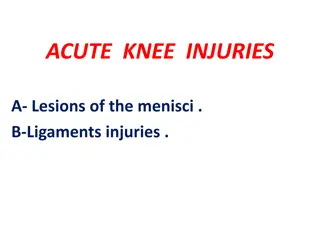Dealing with sports injuries
Anita Turbak, Faculty of Medicine at Rzeszów University, discusses the aims of physiotherapy after sports injury, ways to classify sports injuries, and treatment for soft tissue injuries.
0 views • 15 slides
Spinal injuries
An overview of spinal injuries, including anatomy revision, types of spinal fractures, assessment, management, and common patterns of injuries. It also covers back pain presentation, red flags, differentials, and the structure of vertebrae. The Denis classification of spinal fractures and the most c
3 views • 40 slides
Comprehensive Guide on Injury, Poisoning, and External Causes
This detailed guide covers various aspects of injuries, poisonings, and other consequences from external causes. It includes information on ICD10 and ICD9 coding, recording and treatment details, vocabulary related to different types of injuries, body parts classification, and code structures for di
2 views • 39 slides
Needlestick Injuries Prevention and Safety
Prevent needlestick injuries by avoiding unnecessary needle use, using devices with safety features, and implementing safe work practices. Healthcare professionals should report injuries promptly, participate in training, and get vaccinated. Be cautious when handling surgical sharps to prevent injur
5 views • 10 slides
Make Your Living Space Aromatic with Australian-Made Soy Candle
At Pastel Pines, we proudly offer an exclusive range of Australian-made Soy Candles that are not just candles but a wholesome experience for your senses. \n\nEach candle is meticulously crafted using a blend of the highest quality soy and vegetable wax, ensuring a cleaner burn and promoting sustaina
5 views • 5 slides
How to Burn Incense Without Setting Off Smoke Detector - herbalincense24
Burning incense can transform your space into a sanctuary of calm and tranquility. This guide will show you how to burn incense.\nContact Us:\nText\/WhatsApp: (929) 376-7413\nEmail: info@herbalincense24.com
0 views • 11 slides
Needle Stick Injuries and Prevention
Needle stick injuries are percutaneous piercing wounds caused by needles or other sharp instruments. They pose significant risks, including exposure to blood-borne diseases. Health-care workers are particularly vulnerable, with millions experiencing such injuries annually. Proper training, safe prac
1 views • 35 slides
Burn Injury Complications and Treatment: A Case Study
Alison, a young woman with a burn foot injury, undergoes skin grafting which leads to inflammation and bacterial infection. Despite antibiotic treatment, she develops bacteremia and an abscess. The case study explores burn degrees, skin layers, graft types, inflammation causes, bacterial identificat
1 views • 11 slides
Acute Knee Injuries: Meniscal Tears and Ligament Injuries
Acute knee injuries, such as meniscal tears and ligament injuries, are commonly caused by trauma or twisting motions. Meniscal tears can lead to pain, swelling, and locking of the knee joint, especially in young active individuals. Understanding the anatomy of the knee joint and meniscus, along with
5 views • 56 slides
Vehicle Collisions: Causes, Types, and Injuries
Vehicle collisions involve various types such as front impacts, side impacts, and rear-end collisions, resulting in different injuries like back and head injuries, neck injuries, soft tissue damage, broken bones, and internal injuries. Understanding the causes and effects of collisions can help prev
0 views • 14 slides
Overview of Burn and Scald Injuries and Classification
Burn injuries from dry heat and scald injuries from hot liquids or steam are common forms of thermal injuries. Other etiological classifications include exposure to chemicals, electrical energy, and radiation. The extent of tissue damage is directly related to temperature and duration. Classificatio
2 views • 31 slides
Skin Burn Scars: Diagnostic Codes and Ratings
Explore the diagnostic codes (7800-7805) and ratings for burn scars of the head, face, and neck according to the Skin 38 CFR 4.118 schedule. Understand the criteria for different rating percentages based on visible or palpable tissue loss, distortion, asymmetry, and characteristics of disfigurement.
5 views • 30 slides
First Aid Tips for Common Trauma Injuries
Learn how to manage various trauma injuries such as skull fractures, eye injuries, blowout fractures, epistaxis, mouth injuries, soft tissue injuries, open injuries, and penetrating wounds with practical first aid techniques. From treating bleeding and impaled objects to saving dislodged teeth and c
0 views • 16 slides
Preventing Road Traffic Injuries: A Global Perspective
Road traffic injuries are a significant global issue, causing millions of deaths and injuries annually. This report highlights the complexity and dangers of road traffic systems, emphasizing the need for increased awareness and preventive measures at governmental, industrial, and individual levels.
1 views • 27 slides
Global Burn Ointment Market
The Global Burn Ointment Market is expected to reach USD 1.2 Billion by 2030, at a CAGR of 5.7% during the forecast period 2022 to 2030.\n\n
1 views • 5 slides
Complications of Fractures: Types and Risks
Complications of fractures can be classified as general, local early, and late complications. General complications include shock, embolisms, and fever while local complications involve injuries to nearby tissues and infections. Early local complications can lead to visceral, vascular, nerve injurie
0 views • 29 slides
Burn Wounds: Pathophysiology and Classification
Burn injuries, such as burns and scalds, are complex inflammatory conditions caused by exposure to heat, chemicals, or electricity. This article delves into the pathophysiology of burn wounds, explaining how tissue damage occurs and the classification of burn depths based on layers of skin affected.
0 views • 19 slides
Mechanical Injuries: Types, Classification, and General Principles
Mechanical injuries encompass a variety of harms caused to the body, mind, reputation, or property. These injuries can be classified into medical, legal, and medico-legal categories based on factors like intentionality. The types of mechanical injuries range from blunt force trauma to thermal, chemi
0 views • 79 slides
Management of Closed Head Injuries in an Austere Environment Overview
Understanding the pathophysiology of brain injuries, including intracranial pressure changes and specific injuries such as traumatic brain injury (TBI), skull fractures, brain bleeds, and diffuse axonal injuries. It covers classifications, diagnosis, and treatment approaches for mild/concussion, mod
0 views • 27 slides
Foot Pathologies: Traumatic Injuries and Pressure Injuries
Explore common foot pathologies including traumatic injuries like plantar fasciitis, turf toe, and sprains, as well as pressure injuries such as plantar ulcers and heel spurs. Learn about the causes, symptoms, and treatment options for these conditions.
0 views • 33 slides
Back Injuries and Prevention Methods
More than 1 million workers suffer from back injuries each year, accounting for a significant portion of workplace injuries. These injuries are not only painful but can also have long-term effects. It is crucial to learn how to avoid injuring or re-injuring your back to prevent pain and avoid potent
1 views • 32 slides
Pediatric Firearm Injuries and Future Research Directions
Pediatric firearm injuries are a significant public health concern, with thousands of American children affected annually. Research gaps exist in understanding the causes, consequences, and prevention strategies for pediatric firearm injuries. The lack of surveillance data and research funding hinde
0 views • 16 slides
Injuries to the Cervical and Thoracolumbar Spine
Cervical spine injuries are common, especially in the 15-30 age group, with motor vehicle accidents, falls, and sports being major causes. Male individuals are more prone to injuries. Neurological deficits are associated with specific types of injuries, necessitating prompt imaging for spinal cord i
0 views • 20 slides
Pressure Ulcers and Tissue Injuries Progression
Pressure ulcers, also known as pressure injuries, are localized damages to the skin and underlying soft tissue usually over bony prominences. The National Pressure Ulcer Advisory Panel changed the terminology in 2016 to classify all stages as injuries, not just ulcers. Stages range from non-blanchab
0 views • 13 slides
Birth Injuries in Newborns
Birth injuries in newborns can result from various factors during the birthing process, such as soft tissue injuries and head trauma. Soft tissue injuries like facial abrasions and scleral hemorrhage may occur due to causes like dystocia and forceps delivery. Nursing care involves assessing and reas
0 views • 19 slides
Essential Diwali Safety Tips to Avoid Accidents and Injuries
Enjoy the festive spirit of Diwali safely by following essential safety tips to prevent accidents and injuries. From handling firecrackers outdoors to being prepared for minor and major burn incidents, this guide covers key safety measures to ensure a joyful and hazard-free celebration. Stay informe
0 views • 13 slides
Upper Extremity Injuries and Shoulder Physiology
Upper extremities are prone to various injuries in sports, including sprains, strains, dislocations, fractures, and repetitive motion injuries like arthritis and tendonitis. The shoulder complex involves bones, muscles, tendons, ligaments, and articulations. Joints like the sternoclavicular, acromio
0 views • 63 slides
PACT ACT of 2022: Addressing Comprehensive Toxics Exposure for Veterans
The PACT ACT of 2022, spearheaded by Sergeant First Class Heath Robinson, aims to address comprehensive toxics exposure issues for veterans. The bill includes provisions such as expanded healthcare, improved VA services, recognition of burn pit exposure, enhancement of compensation for Persian Gulf
0 views • 22 slides
Common Sports Injuries by Dr. Ashish Kumar Dubey
Dr. Ashish Kumar Dubey, Assistant Professor in the Department of Physical Education, categorizes common sports injuries into soft tissue injuries, bone injuries, and joint injuries. Soft tissue injuries include sprains, strains, contusions, abrasions, lacerations, and incisions. Sprains are ligament
0 views • 7 slides
Dentoalveolar Injuries: Causes and Classification
Dentoalveolar injuries refer to trauma affecting the teeth and their supporting structures. These injuries can range from isolated incidents to significant maxillofacial damage. They are classified into categories based on the affected tissues, including hard dental tissues, pulp, periodontal tissue
1 views • 18 slides
RICE MACT and its Impact on Air Quality
The RICE MACT (Maximum Achievable Control Technology) regulation aims to reduce emissions of Hazardous Air Pollutants (HAPs) from reciprocating internal combustion engines. It applies to major industrial sources emitting significant amounts of HAPs and outlines emission requirements for different ty
0 views • 26 slides
Overview of Peripheral Nerve Injuries and Brachial Plexus Injuries
Explore different types of peripheral nerve injuries including Erb's palsy, Klumpke palsy, isolated axillary nerve injury, and isolated musculocutaneous nerve injury. Learn about the anatomy, causes, motor and sensory exams, and management of these injuries. Understand the myotomes and dermatomes as
0 views • 19 slides
Debunking Myths About Sweat and Fat Burn - Vighnharta Hospital
Sweating is often misunderstood as a sign of fat burn, but the two are not directly connected. Sweat is your body\u2019s way of cooling down, not an indicator of calorie burn or weight loss. Fat burn happens when your body uses stored fat for energy
4 views • 4 slides
Burn Injuries: Introduction, Classification, Pathophysiology, and Management
Burn injuries can result from various causes such as wet heat, dry heat, electricity, chemicals, and radiation. Understanding the classification, pathophysiology, and management of burn injuries is crucial for effective treatment. Different types of burns, including friction burns, are discussed alo
0 views • 40 slides
Comprehensive Guide to Burn Injuries and Treatment
Burn injuries are caused by various factors such as heat, cold, electricity, chemicals, or radiation. This guide covers the pathophysiology of burns, immediate care steps, pre-hospital and hospital care, criteria for admission to a burn unit, and the impact of inhalational injuries. Learn about how
0 views • 63 slides
Pediatric Burn Patient Airway Management Overview
Understand the critical aspects of early intubation in pediatric burn patients, including challenges with facial and chest burns, appropriate airway placement strategies, respiratory compromise, and mechanical ventilation strategies for optimal outcomes. Explore a case study of a 4-year-old male wit
0 views • 22 slides
The Impact of Mass Burn Incinerators on Waste Management
Explore the controversy surrounding mass burn incinerators as a method of waste disposal, including their effects on recycling, fuel sources, long-term arrangements, and the end of landfill use. Discover the challenges and considerations associated with adopting mass burn incineration technology in
0 views • 5 slides
Hospital Preparedness Program (HPP) Budget Period 4 Burn Surge TTX Tabletop Exercise Initial Planning Meeting
The Hospital Preparedness Program (HPP) Budget Period 4 (BP4) Burn Surge TTX Tabletop Exercise Initial Planning Meeting, scheduled for October 31, 2022, involves trusted agents discussing exercise objectives, planning updates, and timelines in preparation for the upcoming tabletop exercise. Importan
0 views • 30 slides
Burn Therapist Certified (BT-C) Reviewer Training Program
The Burn Therapist Certified (BT-C) Reviewer Training Program aims to promote and recognize occupational and physical therapists specializing in burn rehabilitation. Reviewers are selected based on specific criteria and are required to undergo training and complete mock reviews before evaluating por
0 views • 35 slides
Finger Injuries and Proper Assessment Guidelines
Hand injuries, especially finger injuries, are common in emergency departments. Proper diagnosis and management are crucial to prevent long-term complications. This content covers information on tendon anatomy, nerve innervation, and assessment guidelines for finger injuries.
0 views • 67 slides







































